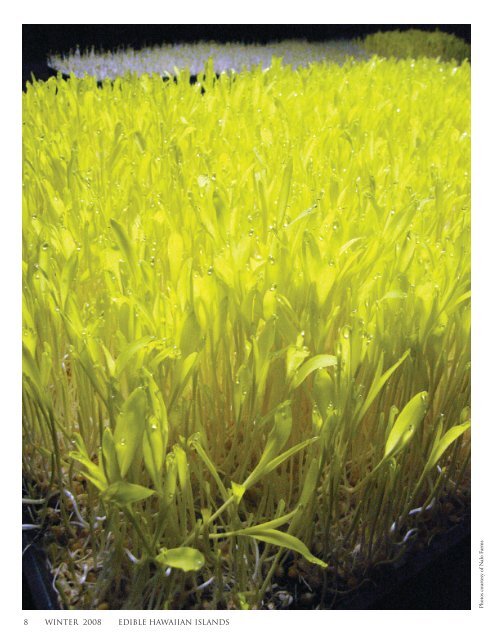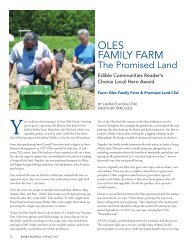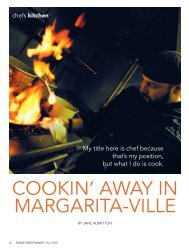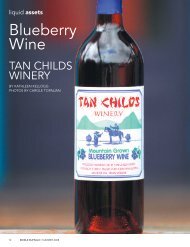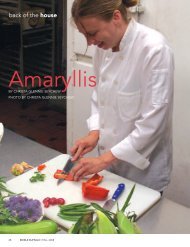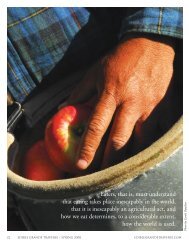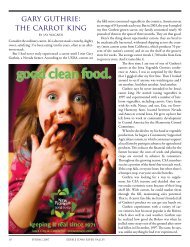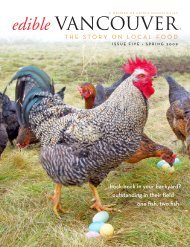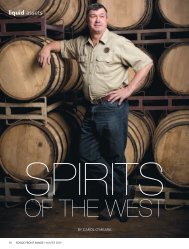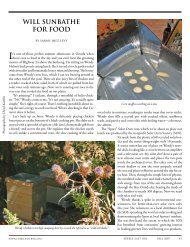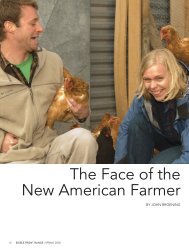Nalo Greens - Edible Communities
Nalo Greens - Edible Communities
Nalo Greens - Edible Communities
Create successful ePaper yourself
Turn your PDF publications into a flip-book with our unique Google optimized e-Paper software.
8 Winter 2008 edible hawaiian islands<br />
Photos courtesy of <strong>Nalo</strong> Farms
`Aina Honua<br />
DEAN OKIMOTO CAPTURES<br />
TASTE OF THE ISLANDS IN NALO GREENS<br />
BY MARI TAKETA<br />
Photos courtesy of <strong>Nalo</strong> Farms<br />
A gentle mist drifts down from the Koolaus as Dean Okimoto surveys<br />
his terrain. On this modest piece of windward O`ahu, acres of baby<br />
greens stud the earth like strands of rubies, emeralds and jade, their<br />
evocative names spanning the globe: Lolla Rossa, tatsoi, Kyona mizuna,<br />
Red Russian kale, French sorrel. Personally selected by Okimoto for<br />
their taste, color and nutritional value, his signature <strong>Nalo</strong> <strong>Greens</strong> have<br />
become a staple of Hawaii Regional Cuisine.<br />
“On the mainland, salad greens are usually grown in cooler conditions,”<br />
he explains. “Ours grow in volcanic soil, in 70- to 90-degree<br />
weather. The flavors are much bolder and zestier.”<br />
Okimoto leans back in his folding chair in an open-air shed, surrounded<br />
by stacks of produce boxes. His shorts and sneakers are clean<br />
and white against the dirt of a working farm. Today the 53-year-old<br />
owner of <strong>Nalo</strong> Farms leaves the bulk of day-to-day operations to his 15<br />
employees and spends half of his time as president of the Hawaii Farm<br />
Bureau, lobbying legislators, supermarket executives and the community<br />
on the benefits of sustainable local agriculture. The ring of his cell<br />
phone interrupts his thoughts every few minutes.<br />
It wasn’t always so. When Okimoto joined his dad, Charles, on the<br />
family fruit and vegetable farm in the 1980s, it was almost as penance.<br />
His parents had put him through prep school in Honolulu and the<br />
University of Redlands in California, and then, in applying to law<br />
school, the brash Okimoto had missed the deadline by one day. When<br />
he was growing up, weeding had been his punishment for breaking<br />
the rules. When he missed that deadline, he had dirt caking his nails<br />
every day.<br />
But he stayed. When his dad retired, Okimoto took over and<br />
planted his acreage in herbs. Most of the land, in fact, was planted in<br />
basil in 1989, when the Fusarium wilt fungus decimated the crop and<br />
left 90 percent of his fields fallow. By then Okimoto was married and<br />
the father of a toddler.<br />
“I was ready to quit. I would have gone on food stamps,” he recalls.<br />
“Then a friend of mine brought Roy over, and Roy told me to<br />
plant baby greens.”<br />
Roy was Roy Yamaguchi. One of the founders of the fledgling<br />
Hawaii Regional Cuisine movement, the young chef had recently<br />
opened his first Roy’s restaurant in Hawaii Kai and was looking for<br />
some multi-flavored local salad greens. Okimoto had nothing to lose.<br />
Together with one employee he started planting, cutting, packing and<br />
delivering a variety of greens, tailoring the mix to Yamaguchi’s requests.<br />
As Roy’s took off, so did <strong>Nalo</strong> <strong>Greens</strong>, which began appearing on<br />
menus throughout Hawaii. An invigorated Okimoto looked up menus<br />
of top restaurants across the country, and when he stumbled across an<br />
unknown green, flipped through his catalogs, ordered the seeds and<br />
experimented. Over time his four acres would eventually grow anywhere<br />
from 35 to 40 varieties of lettuces, microgreens including peppery<br />
Roquette arugula, red mustard and curly cress, and delicate corn<br />
and pea sprouts.<br />
Then master sommelier Chuck Furuya—the friend who had introduced<br />
him to Yamaguchi—invited him on a trip to California. They<br />
rented a car and spent 10 days tasting their way through vineyards from<br />
Eureka to Santa Barbara. Revelation came to Okimoto somewhere in<br />
between, when Furuya had him taste two Chardonnays—one from a<br />
sea-level vineyard, the other from grapes grown at 3,000 feet.<br />
“This was exactly the same grape, but the difference was dramatic.<br />
The sea-level Chardonnay was pungent and bold. The one from the<br />
higher elevation was buttery and mellow,” Okimoto says. “Chuck said,<br />
‘What is wine? It’s farming.’ I thought, ‘Yeah!’”<br />
With that, Okimoto came home and started buying salad mixes<br />
everywhere he could find them, including Costco. All were from the<br />
mainland; salad greens were considered non-mainstream, diversified<br />
agriculture in Hawaii, and no grower had the production capacity or<br />
the processing facilities to meet the food safety standards required by<br />
most supermarkets. Okimoto found that the taste differences between<br />
his warm-weather, sea-level produce and the mainland imports were as<br />
dramatic as those from Furuya’s Chardonnay lesson: his cresses and<br />
arugulas popped off the plate with their pungency, anchoring the<br />
sharper side of his flavor profile and balancing out the softer red and<br />
EDIBLEhawaiianislands.com Winter 2008 9
green oak leaf lettuces and the sweet bursts of his Swiss chards and<br />
Bull’s Blood beet leaves.<br />
The flavor distinctions sharpened his marketing. Okimoto’s<br />
greens, grown with organic pesticides and tons of compost, commanded<br />
high prices compared to mass-produced mainland imports.<br />
He had on his side the powerful arguments of freshness (<strong>Nalo</strong> Farms’<br />
mission statement: “We cut in the morning, we deliver in the afternoon,<br />
and it’s on the customer’s plate that night”) and local sourcing,<br />
which island chefs liked.<br />
Now he could add terroir: the presence of the Waimanalo climate,<br />
soil and landscape in the taste of his greens. His land was in the shadow<br />
of the Koolaus only a mile from the ocean, catching the northeasterly<br />
trade winds and the rain from the clouds that stacked up against the<br />
green-curtained peaks in the winter and spring. He even began to notice<br />
that the peppery microgreens he grew softened their flavors during<br />
the cooler months and roared back in the heat of summer.<br />
Those who liked to eat noticed the differences as well. The popularity<br />
of Hawaii Regional Cuisine percolated from upscale down to<br />
mid-range and even some mom-and-pop plate lunch eateries, and<br />
helped spur a resurgence of farmers’ markets throughout the state.<br />
Okimoto made sure <strong>Nalo</strong> <strong>Greens</strong> were a fixture at every level. He<br />
brought back herbs and braising greens to his offerings, and found they<br />
did well too. With Yamaguchi, now a good friend, he recently launched<br />
Da Farmer and The Chef, selling salad dressings through supermarkets<br />
in Hawaii and California (dafarmerandthechef.com). And when<br />
his processing facility is completed this month, <strong>Nalo</strong> <strong>Greens</strong> should<br />
become available on more supermarket shelves on O`ahu and other islands<br />
later this year.<br />
Okimoto glances out over his fields. Today’s misty drizzle follows<br />
several days of pounding rains. It’s been another rainout day, when<br />
drops push tender leaves into the soil and fleck them with dirt, killing<br />
some and making the rest impossible to harvest. He knows that<br />
throughout the state, other farmers are looking out over waterlogged<br />
crops and calculating their losses as well. As president of the 1,600-<br />
member Hawaii Farm Bureau, he’s grown into the habit of thinking<br />
collectively, and has plowed his marketing energy into forming Local<br />
Island Fresh <strong>Edible</strong>s, which uses <strong>Nalo</strong> Farms’ infrastructure to distribute<br />
other growers’ Hau`ula Vine Ripened Tomatoes, Kahuku Super<br />
Sweet Corn and Kula Country Strawberries to restaurants in Honolulu.<br />
Okimoto’s political energy, meanwhile, is focused on sustainability.<br />
He worries that the high cost of agricultural land and infrastructure<br />
is a disincentive to would-be farmers. He worries that only 4 percent<br />
of the gross state product comes from agriculture, even as demand for<br />
locally grown food continues to rise. He worries that if he and others<br />
fail to raise the alarm with legislators and the public, Hawaii in the future<br />
will become even more dependent on imported foods.<br />
“If I walk into a place and see they’re already using local greens, I<br />
don’t even try to compete,” he says. “As long as they’re buying local, we<br />
all win.”<br />
10 Winter 2008 edible hawaiian islands
DEAN’S AWESOME TOMATO SAUCE<br />
15 pounds vine-ripened tomatoes (Dean takes home castoffs)<br />
2 medium onions, diced<br />
2 bell peppers, diced<br />
3 Tbsp. minced garlic<br />
Olive oil<br />
Salt to taste<br />
1 bag <strong>Nalo</strong> Farms Spaghetti Mix herbs (oregano, basil, thyme, parsley)<br />
Cut tomatoes in half, remove calyxes, throw skins-on into large<br />
stockpot with olive oil and everything except salt and herbs.<br />
Simmer uncovered 3–4 hours, stirring occasionally.<br />
Throw in bagful of <strong>Nalo</strong> Farms herbs and let simmer 15 more minutes.<br />
Add salt to taste. Purée in blender. Freeze most.<br />
To serve, sauté spicy sausage, stir into sauce and serve over pasta.<br />
EDIBLEhawaiianislands.com Winter 2008 11


